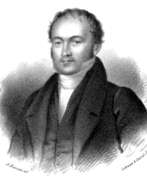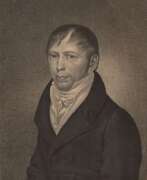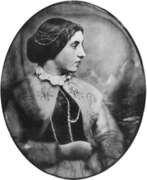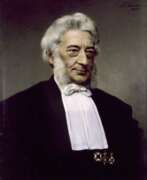Botanists 19th century


Matthieu Bonafous was a prominent French botanist and agronomist.
Bonafous was an innovator in 19th century agronomy, specializing in technical farming, with a particular interest in corn and its economic importance as a food crop. He also studied mulberry trees and created new species for silkworm breeding, and wrote many scientific articles, including one on rice.
As a teacher, Matthieu Bonafous offered a traveling course based on direct contact with practitioners of scientific farming.


Aimé Bonpland, born Aimé Jacques Alexandre Goujaud, was a French and Argentine natural scientist, traveler, physician, and botanist.
Bonpland became famous for his participation in an expedition to the Americas. Together with the explorer Alexander von Humboldt, he traveled through much of the American territory, from Cuman to the United States, passing through Colombia, Ecuador, Peru, Mexico, and Cuba, in addition to Venezuela. In all these places he did a great deal of botanical work, describing and collecting six thousand species of American plants, many of which were new. The scientist made them known in Europe after his return in 1804, publishing several scientific papers. Four years later, Bonpland was appointed botanist of the Empress's Garden.
After more years, he returned to Buenos Aires and continued numerous botanical, zoological, and medical studies in various regions of South America. Bonpland sent plants to the Museum of Natural History in Paris and maintained correspondence with its naturalists.


Lewis David de Schweinitz (also Ludwig David von Schweinitz), born on February 13, 1780, in Bethlehem, Pennsylvania, was a German-American botanist and mycologist. His parents, Hans Christian Alexander and Dorothea Elizabeth von Watteville von Schweinitz, were instrumental in the administration of the Moravian Church in America. Following his early education in Bethlehem, Schweinitz was sent to Germany in 1798 to continue his academic pursuits.
In Germany, Schweinitz enrolled in the Moravian Theological Seminary at Niesky in Silesia. It was there that he met Professor Albertini, who shared his interest in botany. Schweinitz's focus on the study of fungi earned him the title "Father of North American Mycology." His contributions to the field were significant, as he was the first American to concentrate his botanical efforts specifically on fungi.
Among his many accomplishments, Schweinitz produced extensive mycological illustrations and published works on the subject. His manuscripts and watercolor paintings of fungi served as reference materials in the development of his Conspectus, a compendium of his findings and classifications. The impact of his work was so considerable that several taxa were named in his honor, highlighting his legacy in the world of botany and mycology.
Schweinitz passed away on February 8, 1834, but his legacy endures through his scientific contributions and the respect he garnered internationally as a botanist. His life and work continue to be celebrated and studied by those in the field, and his illustrations and findings remain a significant part of mycological history.


Adrian Hardy Haworth was a British scientist of entomology, botany and carcinology, and a Fellow of the Linnean Society.
Haworth made significant contributions to botany and entomology, describing many species of plants and insects. He summarized and published the results of his entomological collections in the extensive Lepidoptera Britannica (1803-1828), which was the first major monograph on the scales of Britain and one of the most authoritative works of the 19th century. Haworth was also a carcinologist and specialized in shrimps.


Friedrich Gottlob Hayne was a German botanist, taxonomist, pharmacist and professor.
After many years of teaching, he was appointed Professor of Pharmaceutical Botany in 1828. In addition to his lecturing duties he led many botanical excursions. He was known for using precise terminology in his plant descriptions.


Jan Kops is a Dutch agronomist, botanist and publisher of thematic journals.
In his youth, Kops was interested in botany, but had to study to become a priest. He soon became disillusioned with a career as a preacher and took up his favorite occupation. The fruit of his botanical research was the first volume of the Flora of Batavia, published in 1800. He was engaged in the task of converting the dunes into agricultural land.
Kops great importance to the country's agriculture lies mainly in his work as the first Dutch agricultural official. He possessed great efficiency and great perseverance. On Kops's initiative, the first Dutch agricultural journal, Magazijn van Vaderlandschen Landbouw, appeared between 1803 and 1814, which he himself edited.


Amelia Hannah Long, Lady Farnborough was a British watercolor artist.
She was the heiress to her parents' art collection and is known as an art connoisseur as well as an accomplished horticultural designer of garden layouts.
In painting, Amelia Long specialized in watercolor landscapes of her home area of Bromley in Kent County. Her work is held in Galleries Scotland, Dundee Art Gallery, the British Museum and Bromley Historical Collections.


Jane Webb Loudon, full name Jane Wells Webb Loudon, is an English futurological writer, one of the pioneers of the science fiction genre, an artist and amateur botanist.
At the age of 20, Loudon wrote the novel that brought her fame, "The Mummy!" (1827). Set in the year 2126, the novel describes an England filled with advanced technology, including automated lawyers and steam-powered surgeons, coffee makers, and an information highway resembling the modern Internet.
Loudon was married to the well-known horticulturist John Claudius Loudon, and they wrote several books together, and she also published her own very successful series of books with titles such as Gardening for Women, A Lady's Companion to the Flower Garden.


Friedrich Miquel, full name Friedrich Anton Wilhelm Miquel, was a Dutch botanist, professor of botany at Utrecht and Amsterdam Universities.
Miquel was also head of the botanical gardens in Rotterdam (1835-1846) and Amsterdam (1846-1859), and was head of the State Herbarium in Leiden from 1862. Friedrich Miquel wrote several books on the flora of the Dutch East Indies. Corresponding with collectors in Australia and Indonesia, he amassed large herbarium collections from these regions.


Peter Simon Pállas was a German and Russian scientist-encyclopedist, naturalist and traveler, who gave almost all his life to the service of Russia.
The breadth of his scientific interests made him a true encyclopedist, but he was particularly interested in natural sciences. By the age of 25, Pallas had already acquired European fame as a major scientist-naturalist. At the same time he received an invitation from the St. Petersburg Academy of Sciences, where he was offered a professorship. In 1767, Pallas arrived in St. Petersburg with his wife and soon led several important expeditions to Siberia and southern Russia. In his numerous ethnographic descriptions, the scientist was the first to report in detail on the Kalmyks, Tatars, Mordvins, Chuvashs, Nagaians, Tungus (Evenks), Votyaks (Udmurts), and Cheremis (Mari). In addition, he brought with him large natural-scientific collections. Later he traveled with scientific expeditions to Kamchatka, the Kuril Islands, Crimea and other previously unexplored lands.
In 1785 Catherine II attracted Pallas to the collection and comparative analysis of the languages of the peoples inhabiting America, Asia, Europe and Russia, and he compiled and published a comparative dictionary in two parts (1787-1789), in which more than 200 languages and dialects of the peoples of Asia and Europe were presented. In the last years of his life, among other things, Pallas was engaged in the preparation of a fundamental three-volume work on the fauna of Russia, Zoographia rosso-asiatica ("Russian-Asiatic Zoology"), in which more than 900 species of vertebrates, including 151 species of mammals, of which about 50 new species were introduced. This work was so extensive, and the descriptions of the animals were so thorough and detailed, that until the early 20th century the book remained the main source of knowledge about the fauna of Russia. In 1810. Peter Pallas went to Berlin to prepare illustrations for this work, but a year later the famous scientist died and was buried in Berlin.
A volcano in the Kuril Islands, a reef off New Guinea, and many animals and plants are named after Pallas.


Alfred William Parsons was a British artist, illustrator and renowned garden designer, a Fellow of the Royal Academy.
He studied at the Kensington School of Art and was a keen gardener thanks to his gardener father. Parsons' favorite subject matter in his paintings is flowering gardens, paths between flowerbeds, and coastal riverscapes. His detailed botanical illustrations led to an acquaintance with William Robinson, one of the great gardeners of his day. He commissioned Parsons to create illustrations for The Wild Garden, and then received his first garden commission from architect Philip Webb. Parsons created several more simple but stunning gardens that harmonized new and traditional elements.
After traveling to Japan, Parsons published his impressions of the country under the title Notes in Japan (1896), and he painted 132 watercolors depicting roses for Ellen Willmott's book Rod Rosa.


Johann Baptist Emanuel Pohl was an Austrian and Czech scientist, botanist, naturalist, and traveler.
Pohl studied in Prague, earned a doctorate in medicine and practiced science, becoming one of the most prominent botanists in Bohemia. Consequently, he was invited on an expedition to Brazil. Johann Pohl arrived in Brazil in 1817 with the Italian botanist Giuseppe Raddi as part of a large scientific expedition sent by Francis I of Austria, and spent four years traveling through the states of Minas Gerais, Goias, Bahia, and Rio de Janeiro, including some 30 rivers in the country. He collected thousands of plant specimens, as well as studying minerals and zoology, exploring gold and diamond mines, caves, and villages of local people.
After his return to Europe, Pohl served as curator of the Vienna Museum of Natural History and the Museum of Brazil in Vienna until his death. His extensive collections, including some 4,000 plant specimens, were housed here along with the expedition's other scientific collections.


Jan Christiaan Sepp was a Dutch book publisher, printmaker and illustrator.
Jan Christiaan Sepp belonged to a dynasty of collectors, publishers and traders in printed books founded by his father, Christian Sepp (c. 1700-1775) in Goslar, Germany. Jan Christian Sepp is known for being the chief illustrator, creating the magnificent engravings for Cornelius Nozeman's highly prized work entitled Nederlandsche Vogelen (Birds of the Netherlands, 1770-1829). These copperplate engravings, superbly composed, meticulously engraved and hand-colored are of great value.
After Christian Sepp's death, the work of illustrating the five volumes was completed by his son, Jan Sepp. Each volume of this five-volume work of science and art contains 50 images of bird species, and each species is described on several pages.


Hermann van Hall or Hermannus Christian van Hall was a Dutch botanist and agrarian, the founder of higher agricultural education.
In 1825, van Hall was appointed professor of botany and land economics at the University of Groningen. He was responsible for a collection of demonstration models, an economic garden and a farm where profitable cash crops were grown. In 1842, he took the initiative to establish the Graduate School of Land Economics in Groningen. The Dutch institute of applied sciences was subsequently named in his honor - Van Hall Larenstein University of Applied Sciences, often abbreviated VHL.


Etienne-Pierre Ventenat was a French botanist, mycologist and writer.
Etienne-Pierre Ventenat was one of the greatest botanists in France. Empress Josephine Bonaparte hired him to describe and catalog rare plants at her castle of Malmaison. Josephine enlisted eminent botanists such as Claes and Blaikie to collect plants on a grand scale. Ventenat was commissioned to write the text of the work on the Malmaison collection, and the illustrations were created by the talented artist Pierre-Joseph Redoute, nicknamed the "Raphael of Flowers." As a result, a sumptuous book entitled Jardin de la Malmaison (The Garden of Malmaison) was published in 1803.


Nikolaus von Jacquin, full name Nikolaus Joseph Freiherr von Jacquin, also Baron Nikolaus von Jacquin, was an Austrian and Dutch scientist, professor of chemistry and botany, and director of the Vienna Botanical Garden.
Jacquin is considered a pioneer of scientific botany in Austria. He wrote fundamental works in botany, was the first to describe many plants, fungi, and animals, introduced experimental methods in chemistry, and successfully campaigned for the introduction of Linnaeus' system of plants in Austria. On behalf of Emperor Franz I, von Jacquin was in charge of the imperial gardens (including Schoenbrunn) and also led a scientific expedition to Central America from 1754 to 1759, from which he returned with an extensive collection of plants.
In 1768, Nikolaus von Jacquin was appointed professor of botany and chemistry at the Faculty of Medicine of the University of Vienna and director of the newly founded botanical garden, which he reorganized according to scientific principles. Nikolaus von Jacquin was a member of the Royal Society of London, a foreign honorary member of the St. Petersburg Academy of Sciences, and a correspondent of the Paris Academy of Sciences.











































